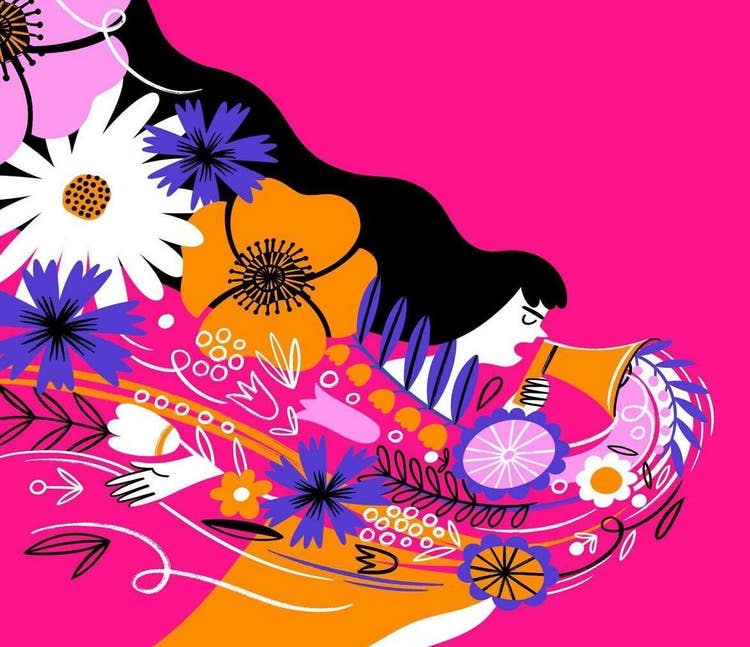Digital accessibility and inclusion remove barriers

Artwork by Yulia Vus.
Today we recognize National Disability Independence Day to enable Creativity for All
It’s been 33 years since the Americans with Disabilities Act (ADA) was signed into law, and it continues to provide important protections from discrimination for people with disabilities. On National Disability Independence Day, it is important to recognize these protections that were put into place so people with disabilities have the same rights and opportunities as everyone else.
The importance of accessibility in the digital world
The ADA has provided valuable protections for the disability community since 1990 by making it clear that all users have the right to access products, information, and services. Without proper guidelines to create more equitable digital access for people with disabilities, technologies continue to include barriers for people with disabilities and those who use assistive technologies.
Creating accessible digital experiences not only provides people with disabilities the access they need, but can enhance experiences for everyone. The Department of Justice (DOJ) is publishing a Notice of Proposed Rulemaking (NPRM) to amend its Title II ADA regulation to provide technical standards to assist public entities in complying with their existing obligations to make their websites accessible to individuals with disabilities.
Even as new regulatory guidance is being considered, it is important to continue to educate and build awareness of the needs of the disability community, including those who use assistive technologies.
As we enter the world of new technologies like generative AI, we unleash exciting new ways to bring transformational experiences to life. If accessibility testing and teams are involved throughout, millions of people could have existing barriers to this technology removed — an outcome that is very much in the spirit of the ADA.
Accessibility by design: What’s new at Adobe
Adobe has been a longtime champion in building tools and experiences that aim to include everyone. To increase inclusion in the digital world, we are committed to developing our technologies in a thoughtful and ethical way, true to our core values.
A few initiatives we would like to callout include:
- The Power of Making Firefly Accessible: Earlier this year, Adobe unveiled Firefly, a new family of creative generative AI models, focused on the generation of images and text effects. We launched the Firefly user interface with many critical accessibility features built in, giving people who use assistive technologies such as screen readers the power to create like never before.
https://main--blog--adobe.hlx.page/media_1f63ab4209b9a1710368cd029d808f3c7ed6afc2b.mp4
Manish Agrawal, the founder of iAccessible, shares his experience using the Firefly tool for the first time and is amazed with the options and ways he could create images and customized text. As a blind person and business owner, he often uses the ability to describe his thoughts as an image or graphic. With Firefly speech to text and its accessible user interface, he can simply use voice-to-text to bring what he is imagining to life – like “astronaut in space.”
- We launched a Bluelines Training course to help designers create user interfaces that are accessible and inclusive of the needs of people with disabilities.
- We recently announced new accessibility updates to Adobe Document Cloud, scaling PDF accessibility. The new PDF Accessibility Auto-tag API leverages Adobe Sensei to help automate and scale the process of tagging PDF content structures. Developers can now easily apply the API to large backlogs of existing untagged PDFs, saving time and budget while improving access.
- We took another step in our mission by signing the ProcureAccess statement. This indicates our commitment to our employees while helping us learn and share best practices with others in the industry. This initiative by Disability:IN brings together companies that recognize the importance of buying and selling technology that is accessible to people with disabilities.
We asked the chair of our Access at Adobe employee network if she had thoughts to share on National Disability Independence Day.
“Progress has been made, but we all know more can be done, barriers still exist” shares Rani Mani, digital media customer comms lead and access at Adobe Chair at Adobe. “For those with disabilities who still aren’t sure if they should make requests based on their needs, I would tell them, dare to be unreasonable, ask for what you need.”
Looking ahead to future legislation considerations
As we reflect on the changing digital environment, we must continue to push for legislation that adapts standards and regulations to further clarify expectations for private and public sectors so we can all do our part to create more inclusive user experiences.
We anticipate receiving proposed regulation from the US DOJ related to Title II of the ADA this year. We will continue to engage in the rulemaking process and make advancements within and outside of Adobe to help remove barriers that create accessible experiences for all.
#DisabilityIndependenceDay #ThanksToTheADA #ADA33 #ADANetwork #DisabilityPride